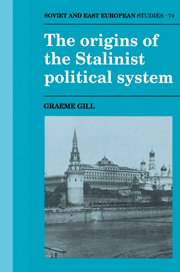Book contents
- Frontmatter
- Contents
- Preface
- Abbreviations
- Introduction: What is Stalinism?
- PART I COHESIVE OLIGARCHY 1917–1922
- PART II THE FRACTURED OLIGARCHY 1922–1929
- Part III THE RE-FORMED OLIGARCHY, 1930–1934
- PART IV THE OLIGARCHY SUBDUED, 1935–1941
- Conclusion: Why Stalinism?
- Notes
- Bibliography
- Index
- Soviet and East European Studies
Conclusion: Why Stalinism?
Published online by Cambridge University Press: 11 September 2009
- Frontmatter
- Contents
- Preface
- Abbreviations
- Introduction: What is Stalinism?
- PART I COHESIVE OLIGARCHY 1917–1922
- PART II THE FRACTURED OLIGARCHY 1922–1929
- Part III THE RE-FORMED OLIGARCHY, 1930–1934
- PART IV THE OLIGARCHY SUBDUED, 1935–1941
- Conclusion: Why Stalinism?
- Notes
- Bibliography
- Index
- Soviet and East European Studies
Summary
The personalised dictatorship that was Stalinism was the product of a long process of institutional development and change and of the fundamental transformation of the notions of what was appropriate in the structuring of internal party life. Both institutional structures and values were changed to produce a political system which was significantly different from that which emerged in the immediate aftermath of October. This does not mean that the two political systems, the Leninist and the Stalinist, did not share parallels and were not linked. There were common elements between the two and some aspects of the earlier period were instrumental in setting the course of development which culminated in the personalised rule of Stalin. But the link between the two was not generative; the second did not flow automatically from the first. While it is true, as many have argued, that the roots of the Stalinist system are to be found in the Leninist, the roots of other paths of development are also present in this early period. What must be explained is why, at crucial stages, these other potential paths were closed off.
For many, the answer to this question has been easy: Stalin. The standard interpretation has been that Stalin was able, through a combination of skill, luck and the incompetence of his opponents, to consolidate his own personal power and to force through the dramatic changes to the system which resulted in his own unbridled personal dictatorship. Clearly, the role of Stalin as a political actor was an important part of the course of events during this period.
- Type
- Chapter
- Information
- The Origins of the Stalinist Political System , pp. 307 - 327Publisher: Cambridge University PressPrint publication year: 1990



